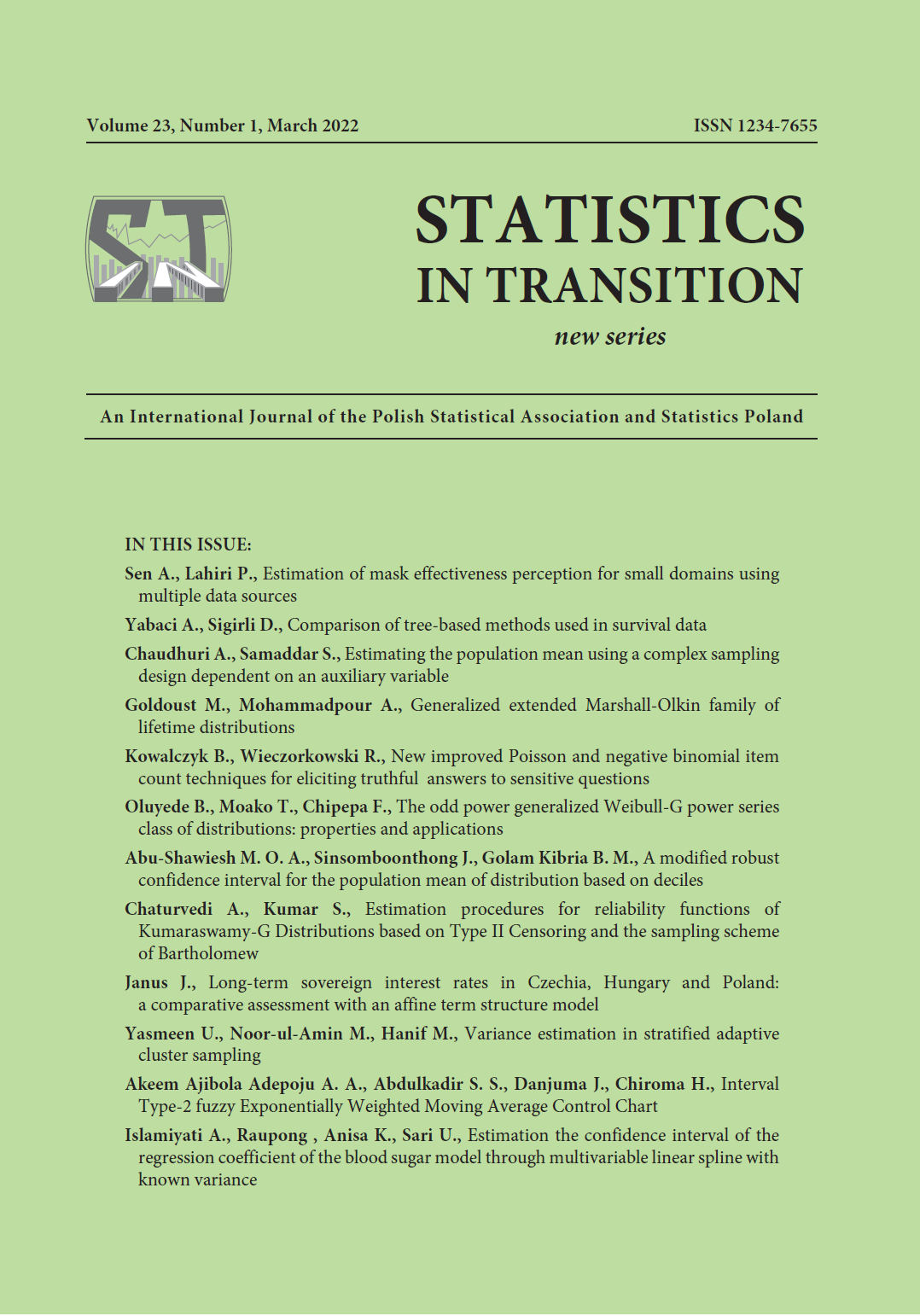ARTICLE
ABSTRACT
Item count techniques (ICTs) are indirect survey questioning methods designed to deal with sensitive features. These techniques have gained the support of many applied researchers and undergone further theoretical development. Latterly in the literature, two new item count methods, called Poisson and negative binomial ICTs, have been proposed. However, if the population parameters of the control variable are not provided by the outside source, the methods are not very efficient. Efficiency is an important issue in indirect methods of questioning due to the fact that the protection of respondents’ privacy is usually achieved at the expense of the efficiency of the estimation. In the present paper we propose new improved Poisson and negative binomial ICTs, in which two control variables are used in both groups, although in a different manner. In the paper we analyse best linear unbiased and maximum likelihood estimators of the proportion of the sensitive attribute in the population in the introduced new models. The theoretical findings presented in the paper are supported by a comprehensive simulation study. The improved procedure allowed the increase of the efficiency of the estimation compared to the original Poisson and negative binomial ICTs.
KEYWORDS
sensitive questions, indirect questioning methods, item count techniques, Poisson ICT, negative binomial ICT, EM algorithm
REFERENCES
Blair, G., Imai, K., (2012). Statistical Analysis of List Experiments. Polit Anal 20, pp. 47–77.
Chaudhuri, A., (2011). Randomized response and indirect questioning techniques in surveys, CRC Press, Boca Raton, FL.
Chaudhuri, A., Christofides, T. C., (2007). Item Count Technique in estimating the proportion of people with a sensitive feature. J Stat Plann Inference 137, pp. 589–593.
Comsa, M., Postelnicu C., (2013). Measuring Social Desirability Effects on Self- Reported Turnout Using the Item-Count Technique. Int J Public Opin Res 25, pp. 153–172.
Dempster, A.P., Laird, N. M., Rubin, D. B., (1977). Maximum-likelihood from incomplete data via the em algorithm, Journal of the Royal Statistical Society Series B, Vol. 39, pp. 1–37.
DIHIDAR, K., BHATTACHARYA, M., (2017). Estimating sensitive population proportion using a combination of binomial and hypergeometric randomized responses by direct and inverse mechanism, Statistics in Transition new series, Vol. 18, No. 2, pp. 193–210.
Holbrook, A. L., Krosnick, J. A., (2010). Social Desirability Bias in Voter Turnout Reports: Tests Using the Item Count Technique. Public Opin Quart 74, pp. 37–67.
Imai, K., (2011). Multivariate regression analysis for the item count technique, Journal of the American Statistical Association, Vol. 206, pp. 407–416.
Imai, K., (2015). Design and Analysis of the Randomized response Technique, Journal of the American Statistical Association, Vol. 110, No. 511, pp. 1304–1319.
Kowalczyk, B., Wieczorkowski, R., (2017). Comparing Proportions of sensitive Items in Two Populations when Using Poisson and Negative Binomial Item Count Techniques, Quantitative Methods in Economics, Vol. 18, pp. 68–77.
Krumpal, I., Jann, B., Korndörfer, M., Schmukle, S., (2018). Item Sum Double-List Technique: An Enhanced Design for Asking Quantitative Sensitive Questions, Survey Research Methods, Vol. 12, pp. 91–102.
Kuha, J., Jackson, J., (2014). The item count method for sensitive survey questions: modeling criminal behavior, Journal of the Royal Statistical Society Series C, Vol. 63, pp. 321–341.
Mclachlan, G. J., Krishnan, T., (2008). EM Algorithm and Extensions, Wiley Series in Probability and Statistics.
Miller Jd. (1994). A new survey technique for studying deviant behavior. PhD Thesis, The George Washington University, USA, 1984.
R Core Team (2020). R: A language and environment for statistical computing. R Foundation for Statistical Computing, Vienna. URL https://www.R-project.org/.
Tian, G-L., Tang, M-L., Wu., Q, Liu Y., (2017). Poisson and negative binomial item count techniques for surveys with sensitive question, Statistical Methods in Medical Research, Vol. 26, pp. 931–947.
Tourangeau, R., Yan, T., (2007). Sensitive questions in surveys. Psychol Bull 133, pp. 859–883.
Trappman, M., Krumpal, I., Kirchner, A., Jann, B., (2014). Item Sum: A New Technique for Asking Quantitative Sensitive Questions, Journal of Survey Statistics and Methodology, Vol. 2, pp. 58–77.
Warner, S. L., (1965). Randomized response: a survey technique for eliminating evasive answer bias. Journal of the American Statistical Association, 60, pp. 63–69.
Wolter, F., Laier, B., (2014). The Effectiveness of the Item Count Technique in Eliciting Valid Answers to Sensitive Questions. An Evaluation in the Context of Self- Reported Delinquency, Survey Research Methods, Vol. 8, pp. 153–168.
